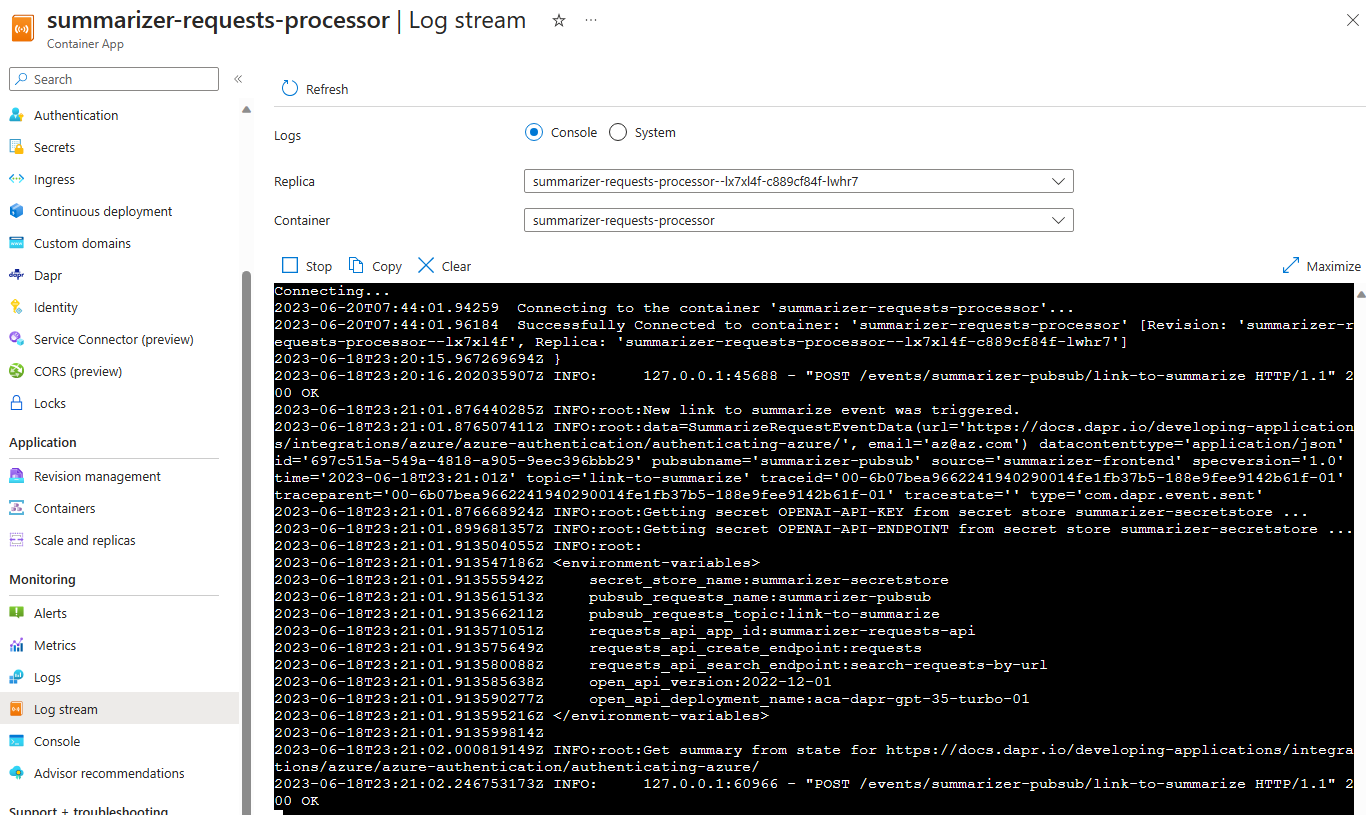Container Apps Deployment (Summarizer microservices)
Table of contents
General Information
In this section, we will deploy the Summarizer apps within the Container Apps environment. This includes the following resources:
- Frontend Blazor App
- Backend Requests API
- Backend Requests Processor
In order to do so, we’ll need to follow below steps :
- Execute docker build and push of all images into the container registry
- Deploy the container apps
Adding the container app in the bicep template
-
Open the
apps.bicepfile, scroll down to the container apps section and call the subsequent module defined or each container app. Pay also attention to the underlying module to understand its behaviors and map it accordingly. -
Frontend Blazor App
Toggle solution
module frontend 'modules/apps/frontend.bicep' = {
name: '${deployment().name}-summarizer-frontend'
params: {
location: location
containerAppsEnvironmentId: containerAppsEnvironment.id
containerRegistryUserAssignedIdentityId: containerRegistryUserAssignedIdentity.id
keyVaultUserAssignedIdentityId: keyVaultUserAssignedIdentity.id
containerRegistryLoginServer: containerRegistry.properties.loginServer
containerAppName: 'summarizer-frontend'
containerAppImage: '${containerRegistry.properties.loginServer}/summarizer/frontend:latest'
containerAppPort: 80
pubSubRequestsName: 'summarizer-pubsub'
pubSubRequestsTopic:'link-to-summarize'
requestsApiAppId:'summarizer-requests-api'
requestsApiEndpoint: 'requests'
}
}
- Requests API
Toggle solution
module requests_api 'modules/apps/requests-api.bicep' = {
name: '${deployment().name}-summarizer-requests-api'
params: {
location: location
containerAppsEnvironmentId: containerAppsEnvironment.id
containerRegistryUserAssignedIdentityId: containerRegistryUserAssignedIdentity.id
keyVaultUserAssignedIdentityId: keyVaultUserAssignedIdentity.id
containerRegistryLoginServer: containerRegistry.properties.loginServer
containerAppName: 'summarizer-requests-api'
containerAppImage: '${containerRegistry.properties.loginServer}/summarizer/requests-api:latest'
containerAppPort: 80
stateStoreName:'summarizer-statestore'
bindingSmtp: 'summarizer-smtp'
}
}
- Requests Processor
Toggle solution
module requests_processor 'modules/apps/requests-processor.bicep' = {
name: '${deployment().name}-summarizer-requests-processor'
params: {
location: location
containerAppsEnvironmentId: containerAppsEnvironment.id
containerRegistryUserAssignedIdentityId: containerRegistryUserAssignedIdentity.id
keyVaultUserAssignedIdentityId: keyVaultUserAssignedIdentity.id
containerRegistryLoginServer: containerRegistry.properties.loginServer
containerAppName: 'summarizer-requests-processor'
containerAppImage: '${containerRegistry.properties.loginServer}/summarizer/requests-processor:latest'
containerAppPort: 80
pubSubRequestsName: 'summarizer-pubsub'
pubSubRequestsTopic:'link-to-summarize'
openAiApiDeploymentName:'aca-dapr-gpt-35-turbo-01'
openAiApiVersion:'2022-12-01'
secretStoreName:'summarizer-secretstore'
requestsApiAppId: 'summarizer-requests-api'
requestsApiCreateEndpoint: 'requests'
requestsApiSearchEndpoint: 'search-requests-by-url'
}
}
Deployment script
Building / pushing the images
- Open the
run-deploy.shfile and add docker build and docker push to the container registry for each image. :
Toggle solution
# echo "Retrieving Container Registry... from previous deployment"
REGISTRY=$(echo $AZ_CAENV_DEPLOYMENT | grep -oE -m 1 '/registries/([^/]+)' | tail -n +2 | cut -d'/' -f3).azurecr.io
echo "Container Registry: $REGISTRY"
# Login to Azure
echo "Logging in to Azure Container Registry..."
az acr login --name $REGISTRY
# Build and push images
echo "Building and pushing images..."
docker build -t $REGISTRY/summarizer/requests-api:latest ../../src/requests-api
docker build -t $REGISTRY/summarizer/requests-processor:latest ../../src/requests-processor
docker build -t $REGISTRY/summarizer/frontend:latest ../../src/frontend
docker push $REGISTRY/summarizer/requests-api:latest
docker push $REGISTRY/summarizer/requests-processor:latest
docker push $REGISTRY/summarizer/frontend:latest
Adding the container apps
- Right next to it, trigger the az deployment of the
apps.bicepusing the az cli command :
Toggle solution
# Deploy Container Apps
echo "Deploying Container Apps..."
AZ_CAENV_DEPLOYMENT=$(az deployment group create \
--resource-group $RESOURCE_GROUP \
--template-file ./apps.bicep \
--parameters ./parameters.jsonc)
- Run the script again
run-deploy.sh, you should now be having three container apps deployed within the Container Apps environment.

Test the application
- Open the
frontendapp in your browser, and test the application by adding a new URL to summarize.You can get the FQDN of the frontend app by running the following command :
az containerapp show -n summarizer-frontend -g <resource-group-name> --query frontendEndpoint -o tsvor using the Azure Portal in the overview section of the container app. - Open the other containers apps logs stream to see the logs of the requests-api and requests-processor apps.
